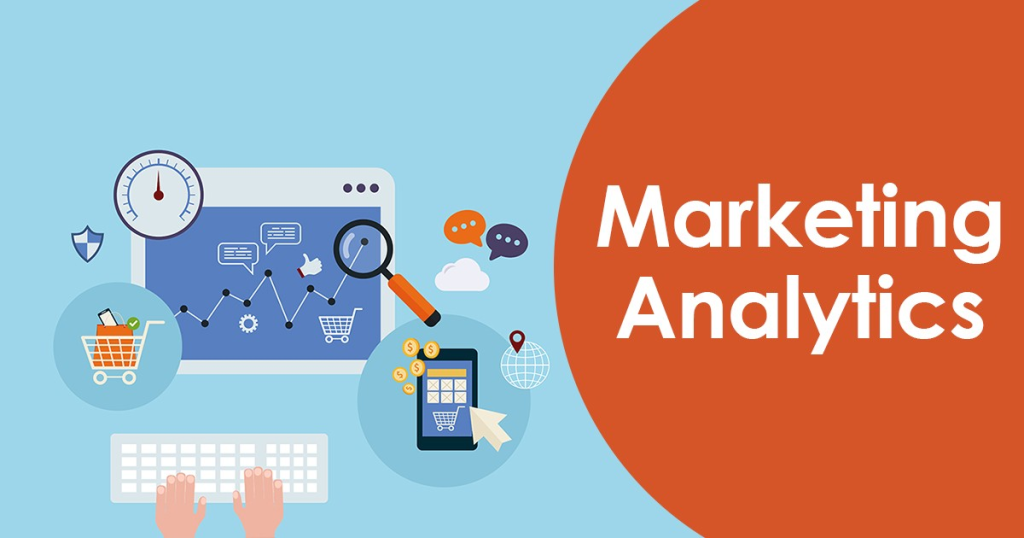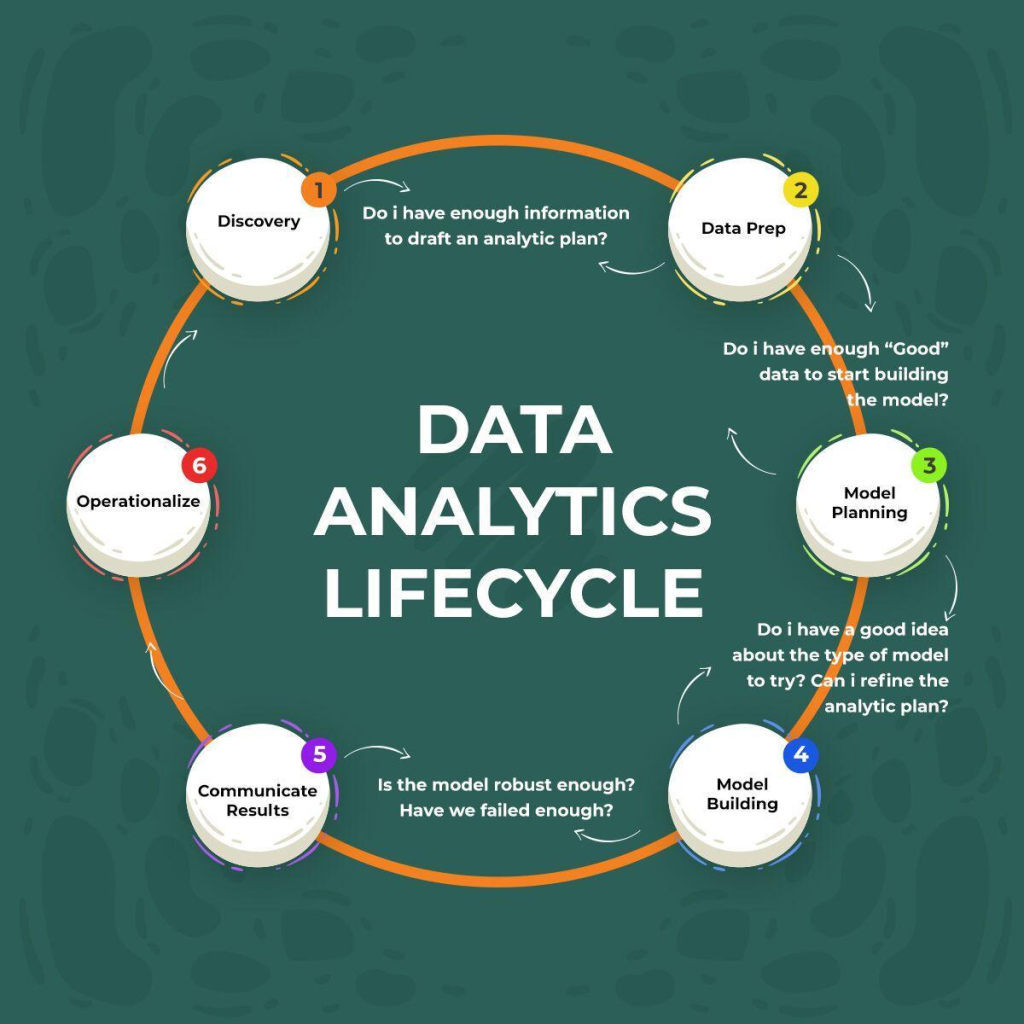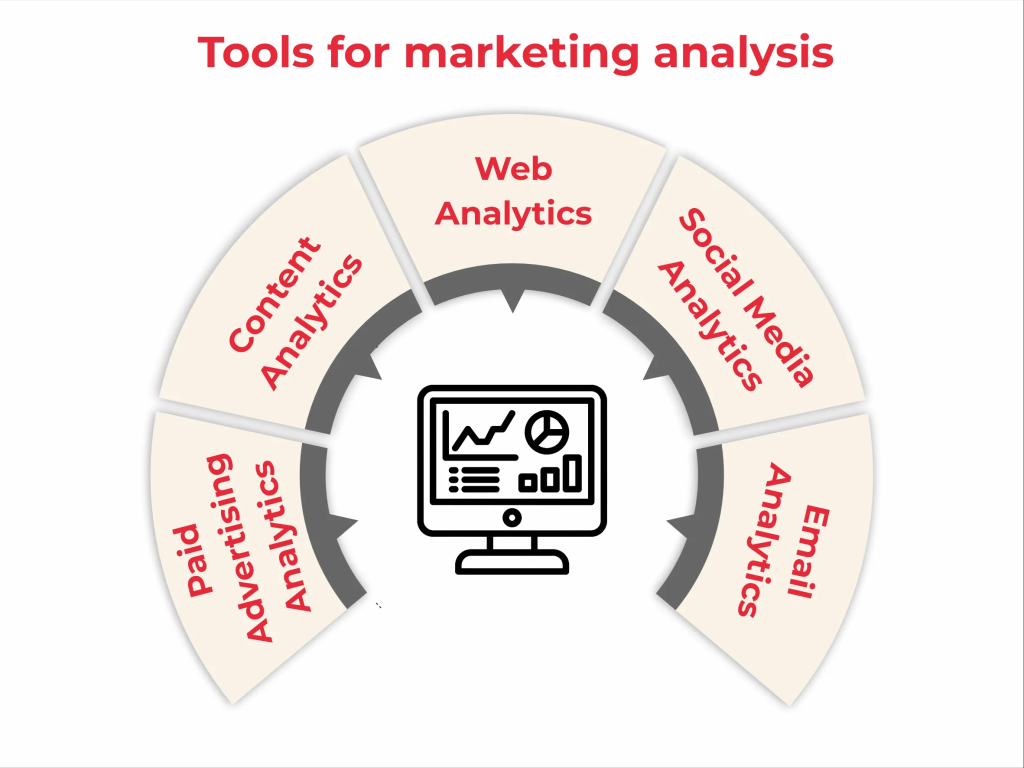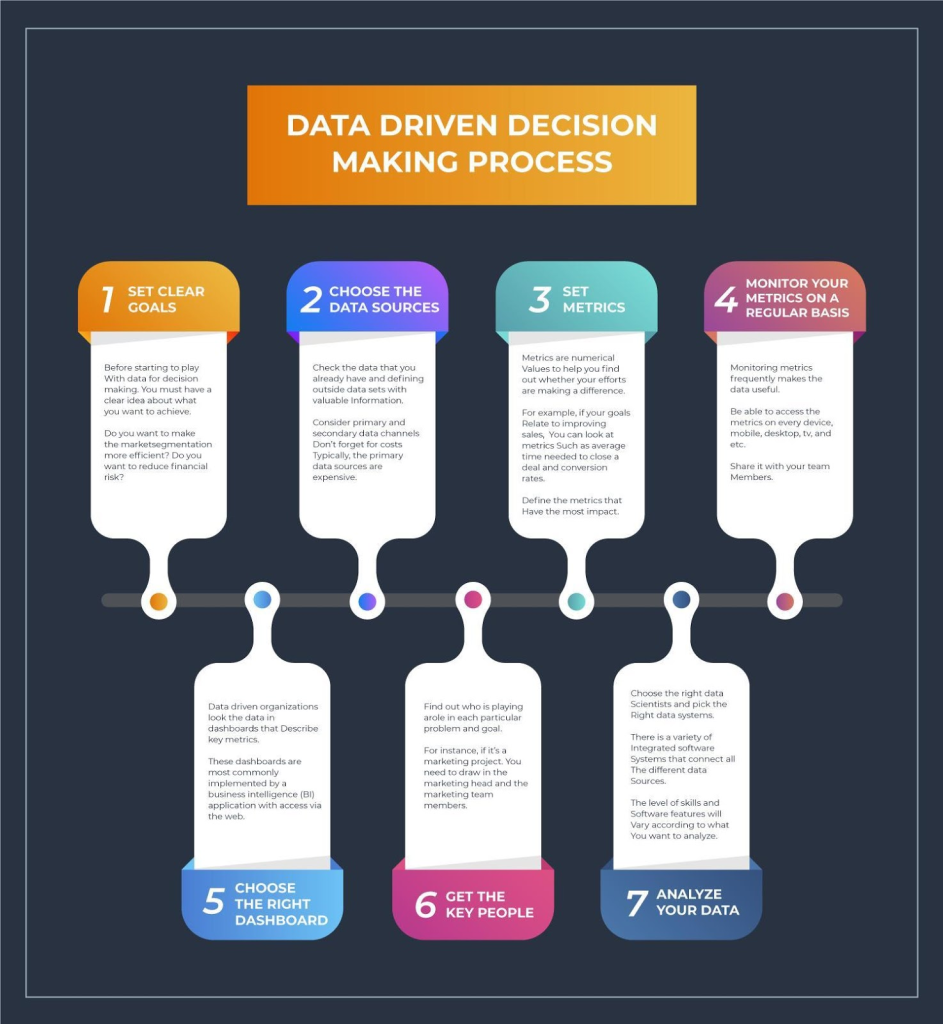
Understanding and utilizing data to drive marketing decisions involves leveraging data analytics and insights to inform and guide marketing strategies. By gathering, organizing, and analyzing data from various sources like customer behavior and market trends, businesses can gain valuable insights that aid in making informed marketing choices.
Data-driven approaches enable businesses to accurately identify target audiences, personalize marketing messages, and optimize marketing channels for maximum impact. Through the use of advanced analytical techniques such as predictive modeling, segmentation, and data visualization, marketers can uncover key metrics and trends that influence marketing success. Regular monitoring and measurement of marketing performance against established goals allow for adjustments and refinements to strategies based on data-derived insights.
By utilizing data effectively, businesses can make informed decisions, allocate resources optimally, and achieve improved results in reaching and engaging their target audience. Data-driven marketing empowers marketers to adapt quickly to changes in the market, enhancing the efficiency and effectiveness of their marketing efforts.
What is marketing data analytics and why do you need it?

Marketing data analytics involves the collection, organization, and analysis of data pertaining to marketing activities and campaigns. It utilizes various tools and techniques to extract valuable insights, identify patterns, and make data-informed decisions, thereby enhancing marketing strategies and outcomes.
The need for marketing data analytics arises from the abundance and significance of data in today’s digital world. By leveraging data analytics, businesses gain a deeper understanding of customer behavior, preferences, and market trends. This knowledge enables marketers to make informed choices regarding target audience identification, message personalization, channel selection, and campaign optimization.
Marketing data analytics provides valuable insights into the effectiveness and return on investment (ROI) of marketing efforts. It helps businesses measure and track key performance indicators (KPIs), identify successful marketing channels, and discover opportunities for improvement. By utilizing data analytics, marketers can enhance targeting accuracy, improve customer segmentation, and customize marketing campaigns to achieve specific objectives.
Furthermore, marketing data analytics enables predictive modeling and forecasting, enabling businesses to anticipate market trends, customer needs, and potential outcomes. It empowers marketers to allocate resources efficiently, optimize marketing budgets, and make strategic decisions that maximize ROI.
In summary, marketing data analytics is crucial for businesses to remain competitive in today’s data-driven landscape. It empowers marketers to uncover actionable insights, make informed decisions, and achieve better results by harnessing the power of data.
Marketing and data analytics defined

Marketing is the process of promoting products or services, attracting customers, and achieving business objectives. It involves understanding customer needs, creating value, and establishing relationships with target audiences.
Data analytics, on the other hand, refers to the practice of collecting, organizing, analyzing, and interpreting data to extract meaningful insights. It employs statistical and analytical techniques to transform raw data into valuable knowledge.
When combined, marketing and data analytics create a powerful approach that uses data-driven insights to inform and optimize marketing strategies. By applying data analytics in marketing, businesses can gain a deeper understanding of customer behavior, preferences, and market trends. This allows them to identify target audiences more accurately, personalize marketing messages, optimize marketing channels, and evaluate the effectiveness of marketing campaigns.
The integration of marketing and data analytics enhances decision-making, improves marketing effectiveness, and drives better business outcomes. Data analytics provides marketers with valuable metrics and insights that guide strategic planning, resource allocation, and campaign optimization. By leveraging data analytics in marketing, businesses can stay competitive, adapt to market changes, and maximize the return on their marketing investments.
The importance of data analytics in marketing

Data analytics plays a vital role in marketing by providing valuable benefits and insights. Here are some key reasons highlighting the importance of data analytics in marketing:
- Customer Understanding: Data analytics helps businesses gain a deeper understanding of customer behavior, preferences, and needs. By analyzing data from various sources like customer interactions, purchase history, and online behavior, marketers can identify patterns and trends that reveal valuable insights. This understanding enables businesses to create more targeted and personalized marketing campaigns that resonate with their audience.
- Improved Targeting and Segmentation: Through data analytics, marketers can segment their target audience based on specific characteristics or behaviors. This segmentation allows for the creation of tailored marketing strategies that address the unique needs and interests of different customer segments. By reaching the right audience with the right message, businesses can improve engagement and conversion rates.
- Optimization of Marketing Efforts: Data analytics helps identify the most effective marketing channels and tactics. By analyzing data on customer engagement, response rates, and conversions across different channels, marketers can optimize their marketing efforts. This optimization ensures that resources are allocated to channels that generate the highest returns, resulting in improved marketing efficiency and cost-effectiveness.
- Measurement and Evaluation: Data analytics provides metrics and insights that allow marketers to measure the performance of their marketing campaigns. By tracking key performance indicators (KPIs) and analyzing relevant metrics, businesses can assess the success of their marketing initiatives. This data-driven approach enables marketers to make informed decisions and refine their strategies for better results.
- Predictive Analysis: Data analytics enables predictive modeling and forecasting, allowing businesses to anticipate customer behavior and market trends. By leveraging historical data and statistical techniques, marketers can make predictions about future outcomes and trends. This predictive analysis helps businesses stay ahead of the competition and make proactive marketing decisions.
In summary, data analytics is vital for effective marketing as it provides valuable customer insights, improves targeting and segmentation, optimizes marketing efforts, enables performance measurement, and supports predictive analysis. By leveraging data analytics, businesses can make informed decisions and enhance their marketing strategies to achieve better outcomes.
Benefits of data analytics in marketing

Data analytics provides numerous benefits to marketing strategies, offering a competitive advantage to businesses. Here are some key advantages of incorporating data analytics into marketing:
- Deeper Customer Understanding: By leveraging data analytics, businesses can gain a deeper understanding of their customers. Analyzing customer data helps identify preferences, behaviors, and needs, allowing marketers to create targeted and personalized marketing campaigns. This understanding enhances customer engagement, satisfaction, and loyalty.
- Improved Targeting and Segmentation: Data analytics enables precise customer segmentation. By analyzing data, businesses can identify distinct customer segments based on demographics, behavior, or preferences. This enables marketers to tailor their messaging and offerings to specific segments, leading to higher conversion rates and more effective marketing strategies.
- Enhanced Campaign Optimization: Data analytics helps optimize marketing campaigns by identifying the most effective channels, messages, and timing. By analyzing data on customer interactions and campaign performance, businesses can refine their strategies, allocate resources more efficiently, and improve overall campaign effectiveness.
- Real-time Decision-making: Data analytics provides real-time insights, enabling marketers to make informed decisions on the spot. By monitoring key metrics and performance indicators in real-time, businesses can respond quickly to market changes, optimize campaigns, and seize opportunities as they arise.
- Measurable ROI: Data analytics allows for accurate measurement and evaluation of marketing efforts. By tracking and analyzing relevant metrics, businesses can assess the success of their marketing campaigns and calculate the return on investment (ROI). This helps allocate resources effectively and make data-driven decisions for future marketing initiatives.
- Predictive Analysis: Data analytics enables businesses to predict future trends and outcomes based on historical data. By leveraging predictive modeling techniques, marketers can anticipate customer behavior, market shifts, and emerging trends. This proactive approach enables businesses to stay ahead of the competition and make strategic marketing decisions.
In conclusion, data analytics provides significant benefits to marketing, including deeper customer understanding, improved targeting and segmentation, enhanced campaign optimization, real-time decision-making, measurable ROI, and predictive analysis. By harnessing the power of data, businesses can drive more effective marketing strategies and achieve better outcomes.
The challenges of marketing data analytics

Implementing marketing data analytics can present businesses with several challenges that need to be addressed effectively. Here are some common challenges associated with marketing data analytics:
- Data Quality and Integration: Ensuring the accuracy, completeness, and consistency of data can be a challenge. Data may come from multiple sources and require integration into a unified format for analysis. Inaccurate or incomplete data can lead to flawed insights and decisions. Businesses need to establish data quality standards, implement data cleansing processes, and ensure seamless integration across systems.
- Data Privacy and Security: The increasing focus on data privacy and security poses challenges for marketing data analytics. Businesses must adhere to regulations and protect customer data from breaches. Striking a balance between utilizing data for analysis while safeguarding privacy requires robust security measures and compliance with relevant laws and regulations.
- Skills and Expertise Gap: Effective data analytics requires skilled professionals with expertise in data analysis, statistical modeling, and interpretation. However, finding and retaining such talent can be a challenge. Businesses may need to invest in training programs or seek external expertise to bridge the skills gap and maximize the value of their data.
- Complexity of Data Analysis: Analyzing large volumes of complex data can be daunting. Extracting meaningful insights and identifying actionable recommendations require advanced analytics techniques and tools. Businesses need to invest in analytics platforms, data visualization tools, and statistical modeling capabilities to handle the complexity of data analysis effectively.
- Alignment with Business Objectives: To derive meaningful insights, marketing data analytics must be aligned with specific business objectives and key performance indicators (KPIs). However, identifying the right metrics and ensuring that analytics efforts support broader marketing goals can be challenging. Close collaboration between data analysts and marketing teams is necessary to define relevant KPIs and measure success accurately.
- Scalability and Infrastructure: As data volumes increase, businesses must ensure that their infrastructure can handle the scale and complexity of data analytics. Scalable storage solutions, computing power, and data processing capabilities are essential for efficient analysis. Upgrading infrastructure and investing in cloud-based solutions can help businesses meet scalability requirements.
- Organizational Adoption and Culture: Integrating data analytics into the organizational culture and ensuring widespread adoption can be a challenge. Resistance to change, lack of data literacy among employees, and organizational silos may hinder the effective utilization of data analytics. Businesses need to foster a data-driven culture, provide training and education, and encourage collaboration across departments to overcome these challenges.
Addressing these challenges requires a comprehensive approach that includes technology investments, talent development, data governance practices, and organizational change management. By overcoming these obstacles, businesses can leverage marketing data analytics to gain valuable insights, make data-driven decisions, and achieve better marketing outcomes.
How can data analytics improve marketing strategy?

Data analytics plays a crucial role in improving marketing strategy by providing valuable insights and driving data-driven decision-making. Here are some key ways in which data analytics can enhance marketing strategy:
- Customer Understanding: Data analytics enables businesses to gain a deeper understanding of their customers. By analyzing customer data, businesses can uncover patterns, trends, and preferences that provide valuable insights into customer behavior. This understanding helps marketers create more targeted and personalized marketing campaigns that resonate with their audience, leading to increased engagement and customer satisfaction.
- Targeted Marketing Campaigns: With data analytics, businesses can segment their target audience more effectively. By analyzing customer data, marketers can identify distinct customer segments based on demographics, behaviors, or preferences. This segmentation allows for the development of tailored marketing campaigns that address the specific needs and interests of each segment, resulting in higher conversion rates and improved campaign effectiveness.
- Channel Optimization: Data analytics helps businesses identify the most effective marketing channels for reaching their target audience. By analyzing data on customer interactions, engagement, and conversions across different channels, marketers can determine which channels yield the best results. This optimization ensures that marketing efforts and resources are focused on the most impactful channels, maximizing the reach and impact of the campaigns.
- Real-time Decision-making: Data analytics provides real-time insights, enabling marketers to make timely and informed decisions. By monitoring key metrics and performance indicators in real-time, businesses can quickly identify trends, opportunities, or issues that require attention. This agility allows marketers to adjust their strategies, optimize campaigns, and respond to market changes promptly, enhancing overall campaign effectiveness.
- Measurement and Evaluation: Data analytics enables marketers to measure and evaluate the performance of their marketing initiatives. By tracking relevant metrics and key performance indicators (KPIs), businesses can assess the success of their campaigns, identify areas for improvement, and make data-driven decisions. This data-driven approach ensures that marketing efforts are aligned with business goals and continuously optimized for better results.
- Predictive Analysis: Data analytics empowers marketers to make predictive forecasts and projections based on historical data and trends. By leveraging predictive modeling techniques, businesses can anticipate customer behavior, market trends, and future outcomes. This predictive analysis helps marketers make informed decisions, identify emerging opportunities, and stay ahead of the competition.
In summary, data analytics enhances marketing strategy by providing valuable insights into customer behavior, enabling targeted campaigns, optimizing marketing channels, facilitating real-time decision-making, measuring campaign performance, and supporting predictive analysis. By leveraging data analytics effectively, businesses can improve their marketing effectiveness, optimize resource allocation, and drive better business outcomes.
How to use data analytics in marketing?

To incorporate data analytics into your marketing strategy effectively, you can follow these step-by-step guidelines:
- Establish Clear Marketing Goals: Begin by defining specific and measurable marketing objectives that align with your overall business goals. These goals should be well-defined and provide a clear direction for your data analytics efforts.
- Identify Relevant Data Sources: Determine the data sources that are most relevant to your marketing objectives. These may include customer databases, website analytics, social media platforms, CRM systems, or any other sources that provide valuable insights about your target audience and marketing performance.
- Collect and Cleanse Data: Gather data from the identified sources and ensure its quality and integrity. Perform data cleansing processes to remove any errors, duplicates, or inconsistencies. Clean and reliable data is essential for accurate analysis and insights.
- Analyze the Data: Apply appropriate data analytics techniques to analyze the collected data. Utilize statistical analysis, data visualization, segmentation, or other analytical methods to uncover patterns, trends, and correlations. Identify key insights that can drive informed marketing decisions.
- Extract Actionable Insights: Translate the data analysis into actionable insights. Focus on extracting insights that directly impact your marketing strategies and tactics. These insights should be specific, relevant, and actionable to guide your marketing efforts effectively.
- Develop Targeted Marketing Strategies: Utilize the derived insights to develop targeted marketing strategies. Segment your audience based on their characteristics and preferences identified through data analysis. Tailor your messaging, offers, and channels to effectively reach and engage each customer segment.
- Monitor and Measure Results: Implement your marketing strategies and closely monitor their performance. Continuously track relevant metrics and KPIs to evaluate the effectiveness of your campaigns. Use data analytics to measure the impact of your marketing efforts and identify areas for improvement.
- Optimize and Iterate: Based on the insights and performance metrics, optimize your marketing strategies iteratively. Make data-driven adjustments to your campaigns, messaging, targeting, and channels. Continuously refine your approach to maximize the ROI of your marketing efforts.
- Stay Updated with Industry Trends: Stay informed about the latest trends and innovations in data analytics and marketing. Explore new tools, technologies, and best practices that can enhance your data analytics capabilities and improve your marketing strategies.
By following these steps, you can effectively utilize data analytics in your marketing strategy. Remember, it’s important to continuously analyze data, extract insights, optimize your strategies, and stay agile in response to changing market dynamics.
Tools used in data analytics for marketing.

Various tools can be utilized for data analytics in marketing. These tools aid in data collection, analysis, visualization, and reporting. Here are some commonly employed tools for marketing data analytics:
- Web Analytics Tools: Popular web analytics tools such as Google Analytics offer comprehensive insights into website performance, user behavior, and conversions. They provide data on website traffic, audience demographics, acquisition channels, and campaign effectiveness.
- CRM Systems: Customer Relationship Management (CRM) systems like Salesforce or HubSpot store and manage customer data. Marketers can leverage CRM tools to analyze customer interactions, track sales funnel progression, and measure customer lifetime value.
- Social Media Analytics Tools: Tools like Sprout Social or Hootsuite provide analytics capabilities for social media platforms. They offer data on social media engagement, follower growth, content performance, and audience demographics. Marketers can assess the impact of social media campaigns and optimize strategies accordingly.
- Data Visualization Tools: Tools such as Tableau, Power BI, or Google Data Studio enable marketers to create visually appealing and interactive dashboards and reports. These tools facilitate data exploration, pattern identification, and effective communication of insights and key performance metrics.
- Marketing Automation Platforms: Marketing automation tools like Marketo or Mailchimp offer analytics functionalities to track and analyze email marketing campaigns, lead generation, and customer engagement. Marketers can assess metrics such as open rates, click-through rates, conversion rates, and campaign attribution.
- A/B Testing Tools: A/B testing tools like Optimizely or Google Optimize enable marketers to conduct experiments and measure the impact of different variations on website conversions, user experience, and engagement metrics. These tools help optimize website design, content, and user flows based on data-driven insights.
- Predictive Analytics Tools: Predictive analytics tools such as IBM Watson Analytics or RapidMiner leverage statistical modeling and machine learning techniques to forecast future outcomes. Marketers can make data-driven predictions about customer behavior, demand forecasting, or campaign performance.
- Data Management Platforms (DMPs): Data Management Platforms like Adobe Audience Manager or Oracle BlueKai collect and consolidate customer data from various sources. They facilitate the creation of unified customer profiles, audience segmentation, and personalized marketing campaigns.
Remember, the choice of tools depends on specific business needs, available data sources, and analytics objectives. It’s crucial to select tools that align with your data infrastructure, provide the required functionalities, and integrate smoothly with existing systems to ensure a seamless analytics workflow.
Data analytics for better marketing decisions.

Data analytics plays a crucial role in improving marketing decision-making through the use of data-driven insights. By harnessing data analytics, marketers can gather valuable information, identify trends, and make predictions that contribute to more effective marketing strategies. Here are some key ways data analytics enhances marketing decision-making:
- Customer Insights: Data analytics enables marketers to gain a deeper understanding of customer behavior and preferences. By analyzing customer data, such as demographics, purchase history, and online interactions, marketers can develop comprehensive customer profiles. This knowledge helps in creating targeted and personalized marketing campaigns that resonate with customers, leading to increased engagement and conversions.
- Campaign Optimization: With data analytics, marketers can monitor and assess the performance of their marketing campaigns in real-time. By tracking metrics like click-through rates, conversion rates, and return on investment (ROI), marketers can identify under-performing campaigns or channels. They can then make data-driven adjustments to optimize their marketing efforts, ensuring efficient resource allocation and maximizing ROI.
- Market Segmentation: Data analytics empowers marketers to segment their target market based on relevant characteristics. By analyzing customer data, marketers can identify common traits, preferences, and behaviors among different segments. This segmentation facilitates the development of tailored marketing strategies, messaging, and offers that resonate with each specific segment, increasing engagement and conversions.
- Predictive Analytics: Data analytics enables marketers to make predictions and forecasts based on historical data and trends. By utilizing predictive modeling techniques, marketers can anticipate customer behavior, market trends, and campaign outcomes. This foresight allows marketers to make proactive decisions and adjust marketing strategies to align with future market dynamics, increasing the likelihood of success.
- Data-Driven Experimentation: With data analytics, marketers can conduct A/B testing and experiments to evaluate the impact of different marketing strategies or variations. By analyzing and comparing the results, marketers can identify the most effective approaches and optimize their campaigns accordingly. This data-driven experimentation allows marketers to make evidence-based decisions and continuously refine their marketing efforts.
- Real-Time Monitoring and Insights: Data analytics provides real-time monitoring of marketing campaigns and performance metrics. Marketers can track and analyze data as it becomes available, enabling timely identification of trends, anomalies, or opportunities. This real-time insight empowers marketers to respond promptly, make necessary adjustments, and seize emerging opportunities to enhance marketing effectiveness.
In summary, data analytics empowers marketers to make informed decisions by providing insights into customer behavior, optimizing marketing campaigns, enabling market segmentation, supporting predictive analytics, facilitating data-driven experimentation, and offering real-time monitoring. By leveraging data analytics effectively, marketers can enhance their decision-making processes, optimize resource allocation, and drive better marketing outcomes.
Thanks,






Leave a Reply
You must be logged in to post a comment.